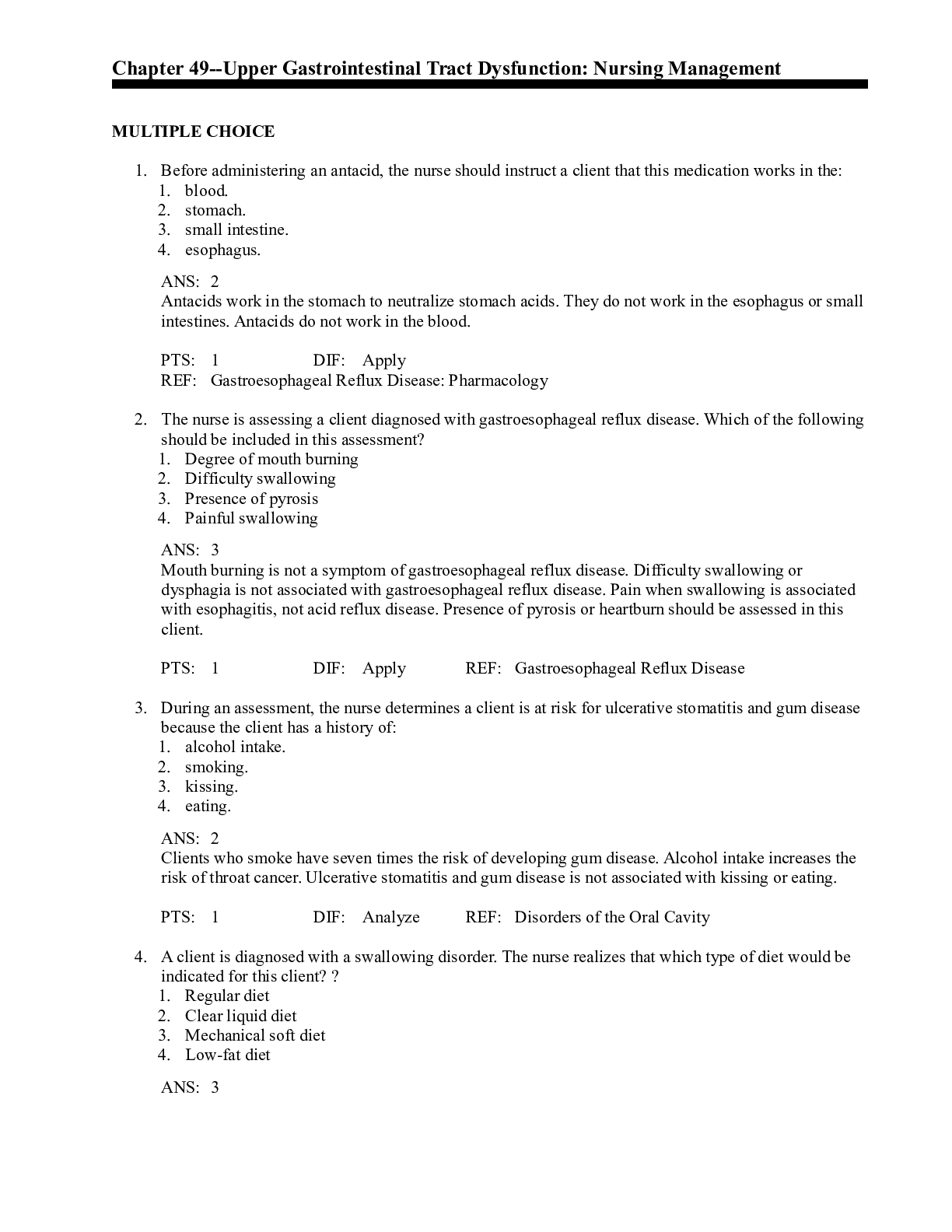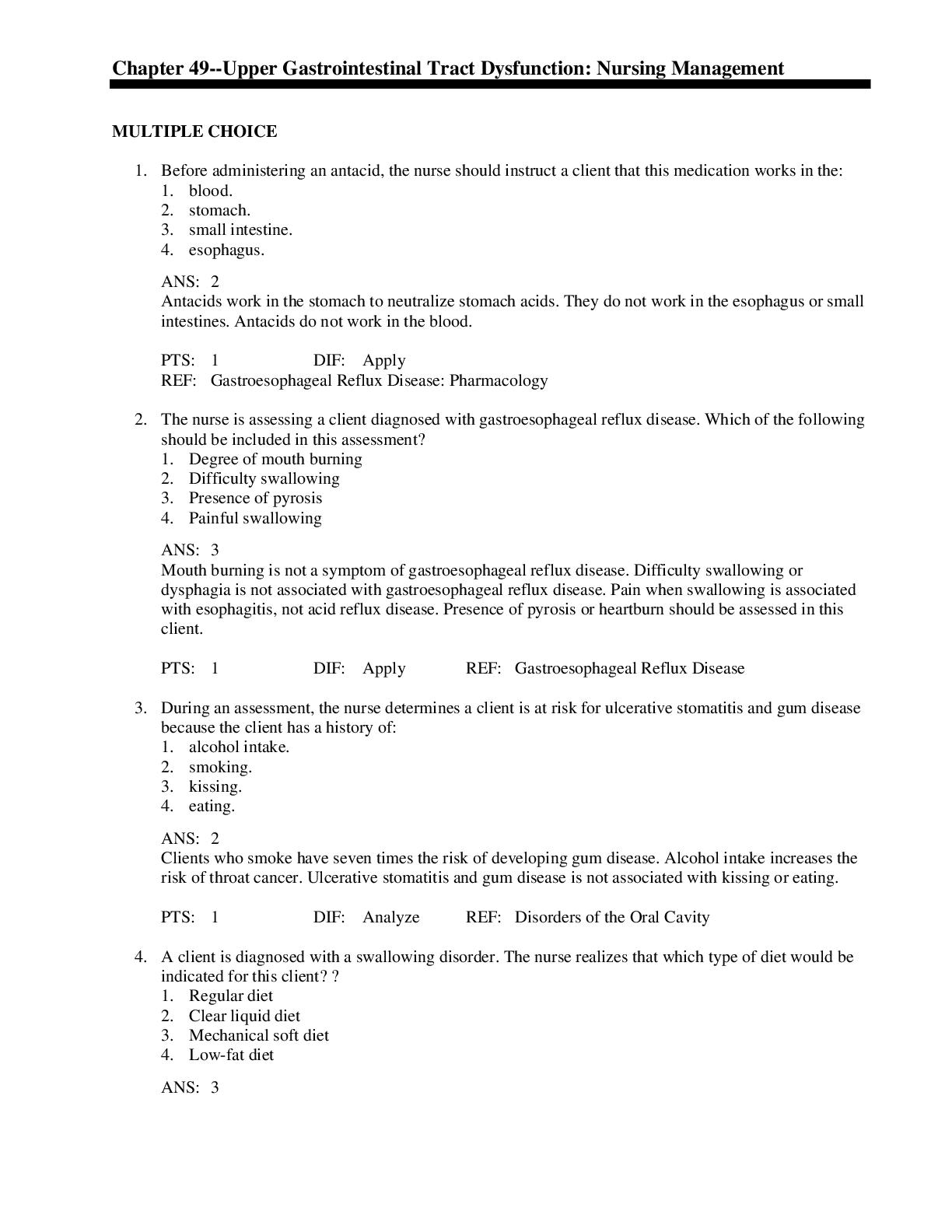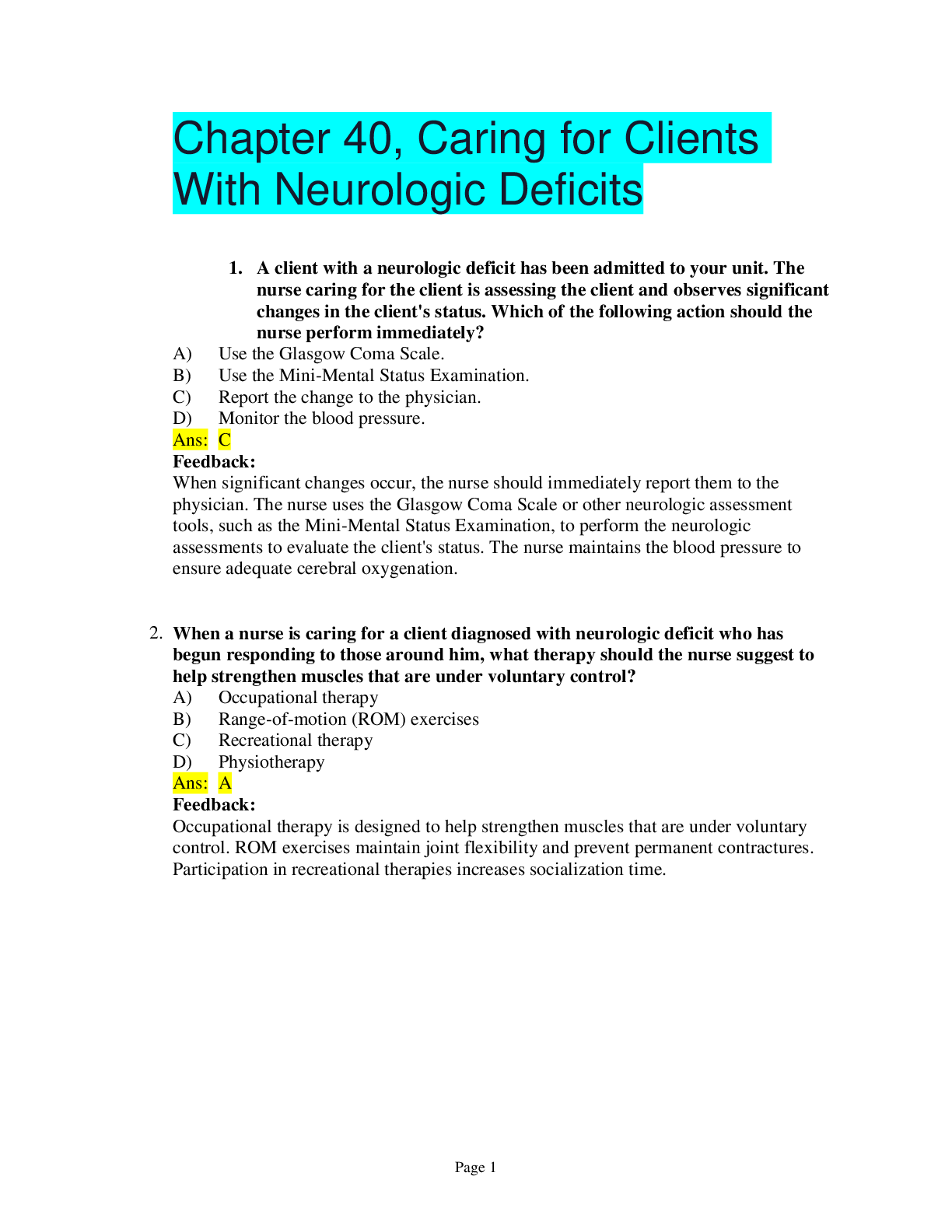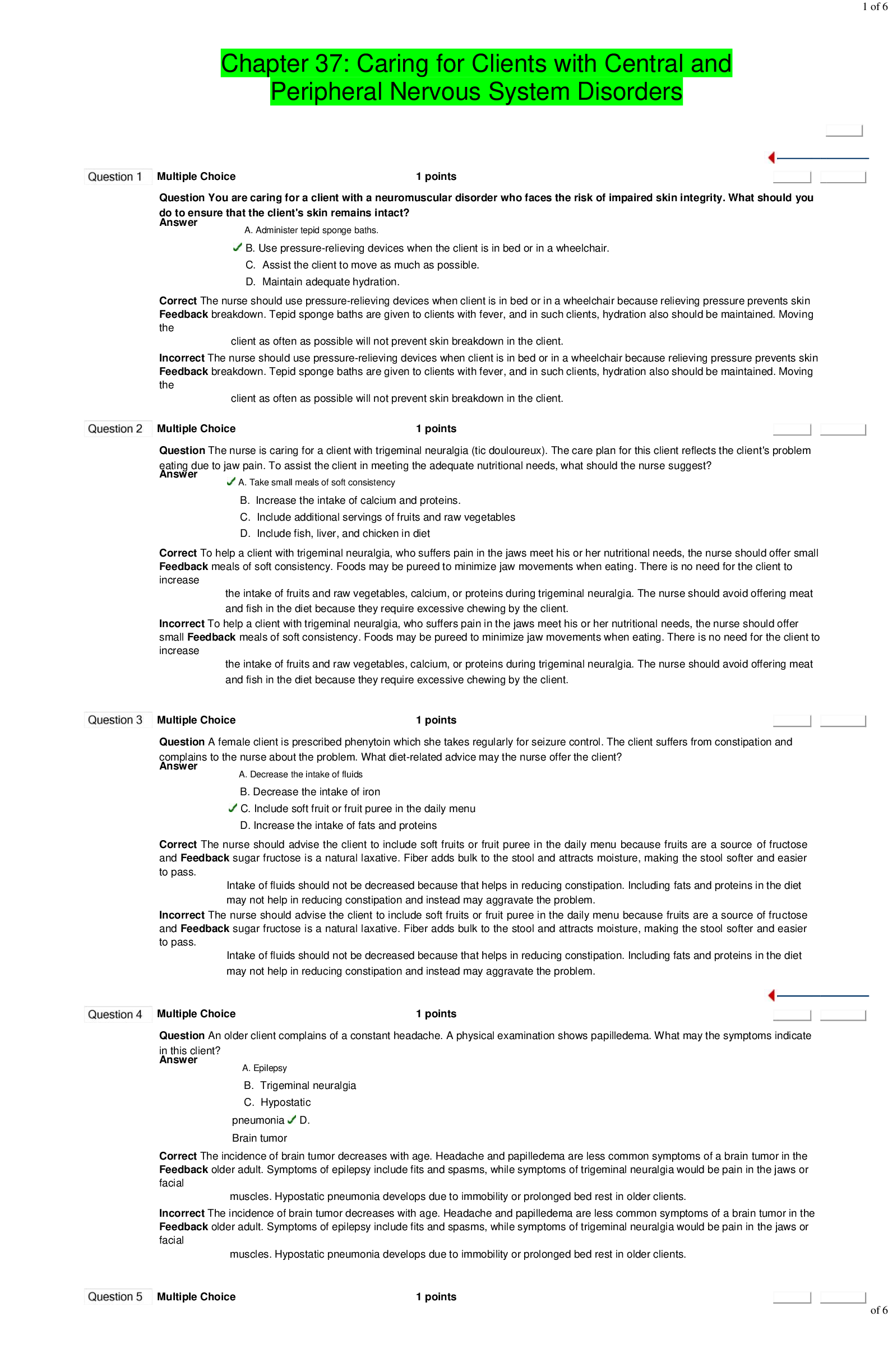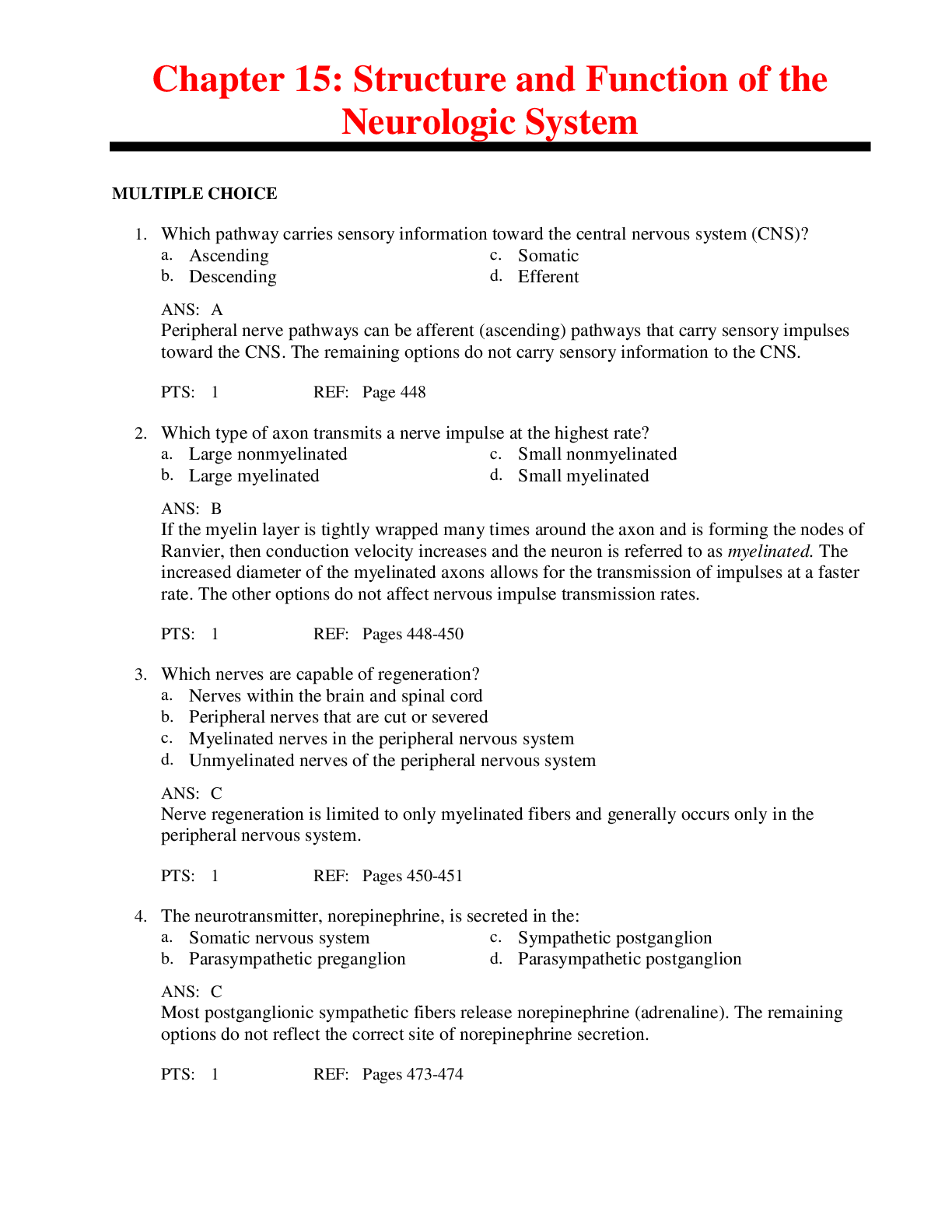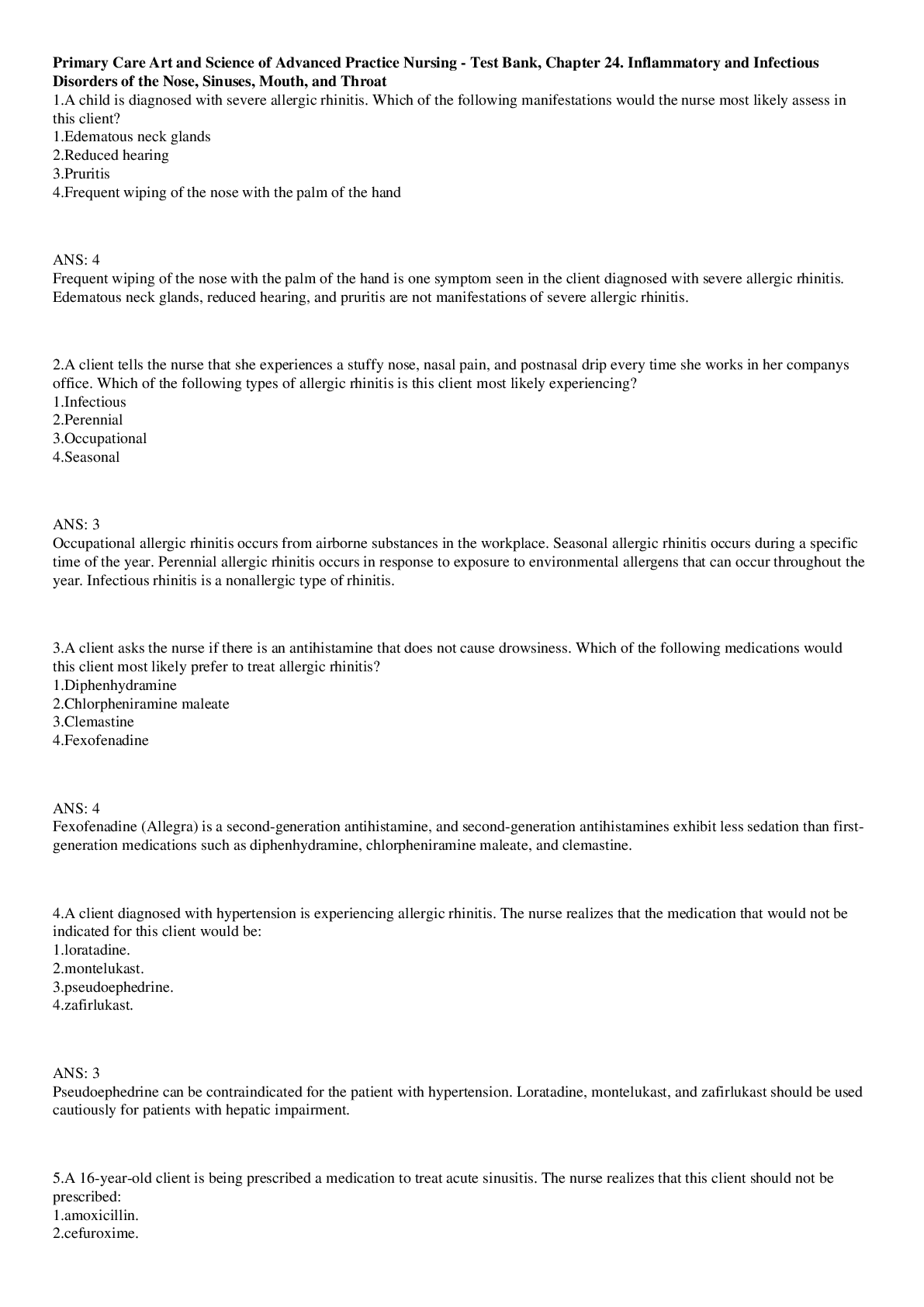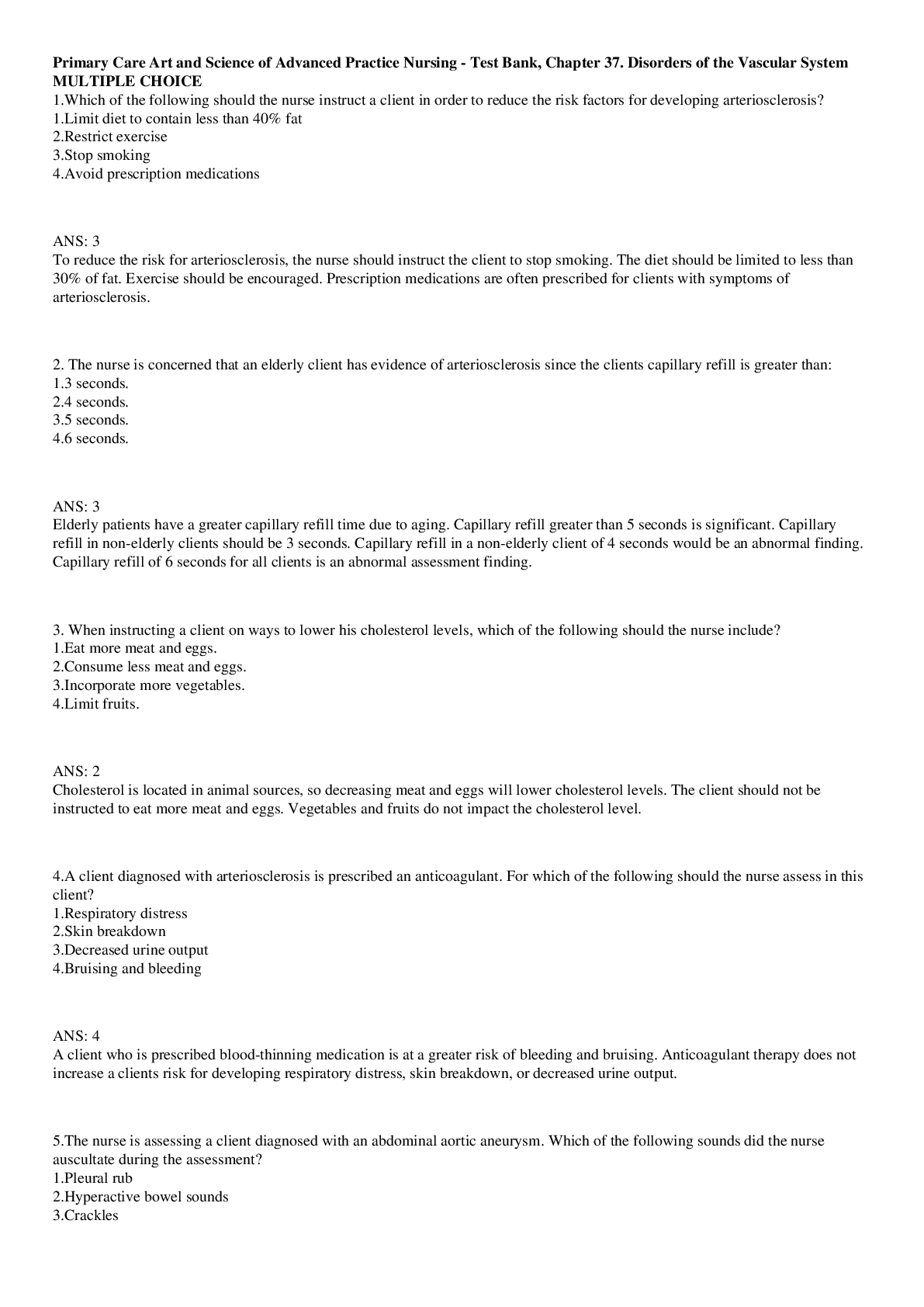*NURSING > QUESTIONS & ANSWERS > Ch. 45-Caring for Clients with Disorders of the Upper Gastrointestinal Tract (All)
Ch. 45-Caring for Clients with Disorders of the Upper Gastrointestinal Tract
Document Content and Description Below
Ch. 45-Caring for Clients with Disorders of the Upper Gastrointestinal Tract A client is admitted to the hospital with an exacerbation of his chronic gastritis. When assessing his nutritional status,... the nurse should expect a deficiency in: A client has received a diagnosis of oral cancer. During client education, the client expresses dismay at not having recognized any early signs or symptoms of the disease. The nurse tells the client that in early stages of this disease: The nurse prepares to administer all of a client's medications via feeding tube. The nurse consults the pharmacist and/or physician when the nurse notes which type of oral medication on the client's medication administration record? The nurse is inserting a nasogastric tube for a patient with pancreatitis. What intervention can the nurse provide to allow facilitation of the tube insertion? A patient taking metronidazole (Flagyl) for the treatment of H. pylori states that the medication is causing nausea. What suggestion can the nurse provide to the patient to alleviate this problem? A nurse is teaching a group of middle-aged men about peptic ulcers. When discussing risk factors for peptic ulcers, the nurse should mention: To prevent gastroesophageal reflux in a client with hiatal hernia, the nurse should provide which discharge instruction? Which is an accurate statement regarding cancer of the esophagus? The client has been taking famotidine (Pepcid) at home. The nurse prepares a teaching plan for the client indicating that the medication acts primarily to achieve which of the following? An older adult patient who has been living at home alone is diagnosed with parotitis. What causative bacteria does the nurse suspect is the cause of the parotitis? Which medication classification represents a proton (gastric acid) pump inhibitor? A client has a radical neck dissection to treat cancer of the neck. The nurse develops the care plan and includes all the following diagnoses. The nurse identifies the highest priority diagnosis as A patient who had a Roux-en-Y bypass procedure for morbid obesity ate a chocolate chip cookie after a meal. After ingestion of the cookie, the patient complained of cramping pains, dizziness, and palpitation. After having a bowel movement, the symptoms resolved. What should the patient be educated about regarding this event? A patient is scheduled for a Billroth I procedure for ulcer management. What does the nurse understand will occur when this procedure is performed? A patient is in the hospital for the treatment of peptic ulcer disease. The nurse finds the patient vomiting and complaining of a sudden severe pain in the abdomen. The nurse then assesses a board-like abdomen. What does the nurse suspect these symptoms indicate? A client is diagnosed with a hiatal hernia. Which statement indicates effective client teaching about hiatal hernia and its treatment? The nurse provides health teaching to inform the client with oral cancer that The nurse instructs the client with gastroesophageal reflux disease (GERD) regarding dietary measures. The client has understood the recommended dietary changes by: A nursing student is caring for a client with gastritis. Which of the following would the student recognize as a common cause of gastritis? Choose all that apply. Which of the following appears to be a significant factor in the development of gastric cancer? Which of the following is the most successful treatment for gastric cancer? The nurse is inserting a Levin tube for a patient for gastric decompression. The tube should be inserted to 6 to 10 cm beyond what length? The nurse is obtaining a history on a patient who comes to the clinic. What symptom described by the patient is one of the first symptoms associated with esophageal disease? A nurse is providing follow-up teaching at a clinic visit for a client recovering from gastric resection. The client reports sweating, diarrhea, nausea, palpitations, and the desire to lie down 15 to 30 minutes after meals. The nurse suspects the client has: A client receives tube feedings after an oral surgery. The nurse manages tube feedings to minimize the risk of aspiration. Which measure should the nurse include in the care plan to reduce the risk of aspiration? A patient describes a burning sensation in the esophagus, pain when swallowing, and frequent indigestion. What does the nurse suspect that these clinical manifestations indicate? A patient has been diagnosed with a hiatal hernia. The nurse explains the diagnosis to the patient and his family by telling them that a hernia is a (an): A client who can't tolerate oral feedings begins receiving intermittent enteral feedings. When monitoring for evidence of intolerance to these feedings, the nurse must remain alert for: A client reports to the clinic, stating that she rapidly developed headache, abdominal pain, nausea, hiccuping, and fatigue about 2 hours ago. For dinner, she ate buffalo chicken wings and beer. Which of the following medical conditions is most consistent with the client's presenting problems? A patient comes to the clinic complaining of pain in the epigastric region. The nurse suspects that the patient's pain is related to a peptic ulcer when the patient states the pain is relieved by what? A client with hiatal hernia reports heartburn and belching that increases when bending at the waist. Which measures would help ease the client's discomfort? The most common symptom of esophageal disease is Which term describes a reddened, circumscribed lesion that ulcerates and becomes crusted and is a primary lesion of syphilis? A client undergoes total gastrectomy. Several hours after surgery, the nurse notes that the client's nasogastric (NG) tube has stopped draining. How should the nurse respond? The nurse is assessing a client with an ulcer for signs and symptoms of hemorrhage. The nurse interprets which condition as a sign/symptom of possible hemorrhage? A patient has been NPO for two days anticipating surgery which has been repeatedly delayed. In addition to risks of nutritional and fluid deficits, the nurse determines that this patient is at the greatest risk for: A 59-year-old woman with a recent history of heartburn, regurgitation, and occasional dysphagia has been diagnosed with a sliding hiatal hernia following an upper GI series. The nurse is providing patient education about the management of this health problem. What should the nurse suggest as a management strategy to this patient? The nurse is caring for a patient who has a gastrostomy tube feeding. Upon initiating her care, the nurse aspirates the gastrotomy tube for gastric residual volume (GRV) and obtains 200 mL of gastric contents. What is the priority action by the nurse? A patient has been taking a 10-day course of antibiotics for pneumonia. The patient has been having white patches that look like milk curds in the mouth. What treatment will the nurse educate the patient about? Which medication is classified as a histamine-2 receptor antagonist? Rebound hypoglycemia is a complication of parenteral nutrition caused by The nurse teaches the client with gastroesophageal reflux disease (GERD) which measure to manage the disease? • Which ulcer is associated with extensive burn injury? • What is the pH of gastric aspirate? • The patient is concerned about leakage of gastric contents out of the gastric sump tube the nurse has just inserted. What would the nurse do to prevent reflux gastric contents from coming through the blue vent of a gastric sump tube? Which of the following medications, used in the treatment of GERD, accelerate gastric emptying? • The nurse in the ED admits a client with suspected gastric outlet obstruction. The client’s symptoms include nausea and vomiting. The nurse anticipates that the physician will issue which order? The nurse working in the recovery room is caring for a client who had a radical neck dissection. The nurse notices that the client makes a coarse, high-pitched sound upon inspiration. Which intervention by the nurse is appropriate? The nurse is caring for a comatose patient and administering gastrostomy feedings. What does the nurse understand is the reason that gastrostomy feedings are preferred to nasogastric (NG) feedings in the comatose patient? A patient who is HIV positive comes to the clinic and is experiencing white patches with rough hairlike projections. The nurse observes the lesions on the lateral border of the tongue. What abnormality of the mouth does the nurse determine these lesions are? A nurse practitioner, who is treating a patient with GERD, knows that responsiveness to this drug classification is validation of the disease. The drug classification is: • Proton pump inhibitors. A patient with gastroesophageal reflux disease (GERD) has a diagnosis of Barrett's esophagus and has been admitted to a medical unit. The nurse is writing a care plan for this patient. What information is essential to include? A nurse inspects the Stensen duct of the parotid gland to determine inflammation and possible obstruction. What area in the oral cavity would the nurse examine? While caring for a patient who has had radical neck surgery, the nurse notices an abnormal amount of serosanguineous secretions in the wound suction unit during the first postoperative day. What does the nurse know is an expected amount of drainage in the wound unit? A patient has had a gastrostomy tube inserted. What does the nurse anticipate the initial fluid nourishment will be after the insertion of the gastrostomy tube? Which medication taken by clients with obesity improves cardiovascular disease risk factors in obese clients with metabolic syndrome? • A nurse is performing discharge teaching with a client who had a total gastrectomy. Which statement indicates the need for further teaching? The nurse is reviewing the chart of a client with swallowing problems. Which of the following factors would raise suspicion that the client has cancer of the esophagus? Choose all that apply. Which are accurate clinical manifestations associated with hemorrhage? Select all that apply. [Show More]
Last updated: 1 year ago
Preview 1 out of 18 pages

Buy this document to get the full access instantly
Instant Download Access after purchase
Add to cartInstant download
We Accept:

Reviews( 0 )
$15.00
Document information
Connected school, study & course
About the document
Uploaded On
Apr 19, 2020
Number of pages
18
Written in
Additional information
This document has been written for:
Uploaded
Apr 19, 2020
Downloads
0
Views
47













